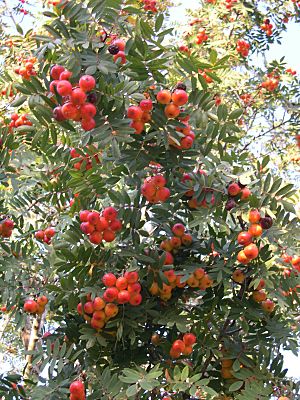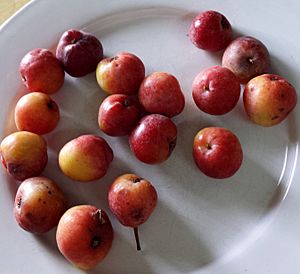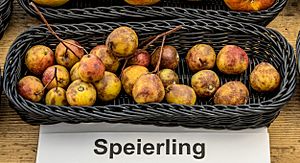Service tree facts for kids
Quick facts for kids Service tree |
|
|---|---|
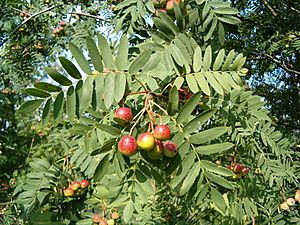 |
|
| Conservation status | |
| Scientific classification | |
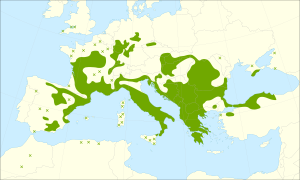 |
|
| Distribution map | |
| Synonyms | |
|
The service tree or sorb tree (scientific name: Sorbus domestica) is a type of tree found in Europe, Northwest Africa, and Southwest Asia. People sometimes call it the true service tree to tell it apart from other similar trees.
This tree can grow quite tall, usually between 15 to 20 meters (about 50 to 65 feet), but sometimes even up to 30 meters (nearly 100 feet)! Its trunk can be as wide as 1 meter (3 feet). However, in windy places, it might grow as a smaller bush, only 2 to 3 meters tall.
The bark of young service trees is smooth and brown. As the tree gets older, its bark becomes cracked and flaky. In winter, the tree's buds are green and a bit sticky.
The leaves are about 15 to 25 centimeters (6 to 10 inches) long. Each leaf has many smaller leaflets, usually 13 to 21 of them. These leaflets are about 3 to 6 centimeters long and have jagged edges.
In late spring, the service tree produces flowers. These flowers are small, about 13 to 18 millimeters (half an inch) wide. They have five white petals and 20 creamy-white parts called stamens. Many flowers grow together in a cluster. Insects help pollinate these flowers.
The fruit of the service tree is called a pome. It's about 2 to 3 centimeters (1 inch) long and looks greenish-brown. The side of the fruit that gets a lot of sunlight often turns red. The fruit can be shaped like an apple or a pear.
Contents
Where Does the Service Tree Grow?
The service tree is quite rare in many places. It's considered an endangered species in countries like Switzerland and Austria. It's also not very common in Spain.
In the United Kingdom, there was a very old service tree in the Wyre Forest. Sadly, it was destroyed by fire in 1862. People used to think it was a wild tree, but now they believe it might have been planted a long time ago, perhaps near a monastery.
More recently, a small group of wild service trees was found growing on cliffs in South Wales and Southwest England. These trees often grow as small, stunted bushes because of the harsh conditions. The largest group of these trees in England is near Bristol. Another group was found growing wild on a cliff in Cornwall.
Service trees can live for a very long time. Some trees in Britain are thought to be 300 to 400 years old!
One of the biggest and oldest known service trees in Europe is in the Czech Republic. Its trunk is huge, measuring about 462 centimeters (over 15 feet) around! This tree is estimated to be around 450 years old.
How People Use the Service Tree
The fruit of the service tree is used to make a drink that is similar to cider in some parts of Europe. If you pick the fruit straight from the tree, it tastes very bitter and gritty. However, if you let it sit and get very ripe (this process is called "bletting"), it becomes sweet and much nicer to eat.
In a region of the Czech Republic called Moravian Slovakia, there's a special museum dedicated to the service tree. They even have a festival for it! People there make things like jam, juice, and a type of brandy from the fruit.
The wood from the service tree is very strong and dense. Because of this, it was often used to make wooden tools, especially planes for working with wood.
What's in a Name?
The English name "service tree" comes from an old English word, which was borrowed from the Latin word sorbus. It's not related to the word "serve" (like serving food).
Other names for this tree include "sorb" and "whitty pear." The name "whitty" comes from the fact that its leaves look a bit like those of a rowan tree. It's called "pear" because of the shape of its fruit. The name "sorb" also comes from the Latin word sorbus. It has nothing to do with the Slavic people called the Sorbs or Serbs.
See also
 In Spanish: Sorbus domestica para niños
In Spanish: Sorbus domestica para niños



